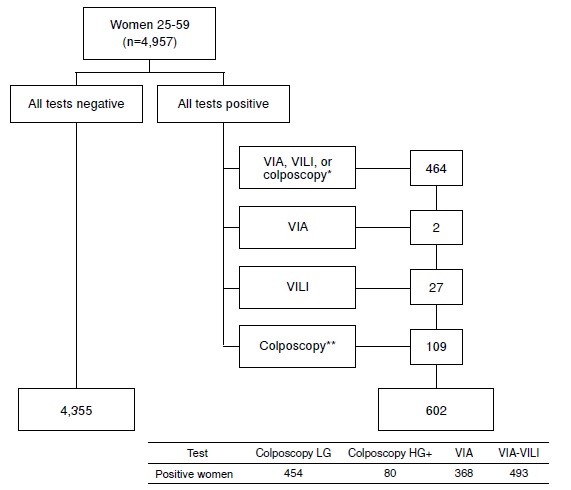Visual techniques for cervical cancer screening in Colombia
Abstract
Introduction: Direct visual inspection for cervical cancer screening remains controversial, whereas colposcopy-biopsy is considered the gold standard for diagnosis of preneoplastic cervical lesions.
Objectives: To determine the rates of cervical intraepithelial neoplasia grade 2 or more and of false positives for colposcopy and direct visual inspection.
Materials and methods: Women aged 25-59 underwent direct visual inspection with acetic acid (VIA), Lugol’s iodine (VIA-VILI), and colposcopy. Punch biopsies were obtained for all positive tests. Using histology as the gold standard, detection and false positive rates were compared for VIA, VIA-VILI, and colposcopy (two thresholds). Sensitivity and false positive ratios with the corresponding 95% confidence intervals were estimated.
Results: We included 5,011 women in the analysis and we obtained 602 biopsies. Positivity rates for colposcopy high-grade and low-grade diagnosis were 1.6% and 10.8%. Positivity rates for VIA and VIA-VILI were 7.4% and 9.9%. VIA showed a significantly lower detection rate than colposcopy with low-grade diagnosis as the threshold (SR=0.72; 95% CI 0.57-0.91), and significantly lower false positive rate (FPR=0.70; 95% CI 0.65-0.76). No differences between VIA-VILI and colposcopy low-grade threshold were observed. VIA and VIA-VILI showed significantly higher detection and false positive rates than colposcopy high-grade threshold. Sensitivity rates for visual inspection decreased with age and false positive rates increased. For all age groups, false positive rates for VIA and VIA-VILI were significantly higher than colposcopy.
Conclusions: Detection rates for VIA-VILI similar to colposcopy low-grade threshold represent a chance to reduce cervical cancer mortality through see-and-treat approaches among women with limited access to health care. Lower detection rates suggest reviewing high-grade colposcopy findings as the threshold for biopsy in certain settings.
Downloads

| Article metrics | |
|---|---|
| Abstract views | |
| Galley vies | |
| PDF Views | |
| HTML views | |
| Other views | |

























